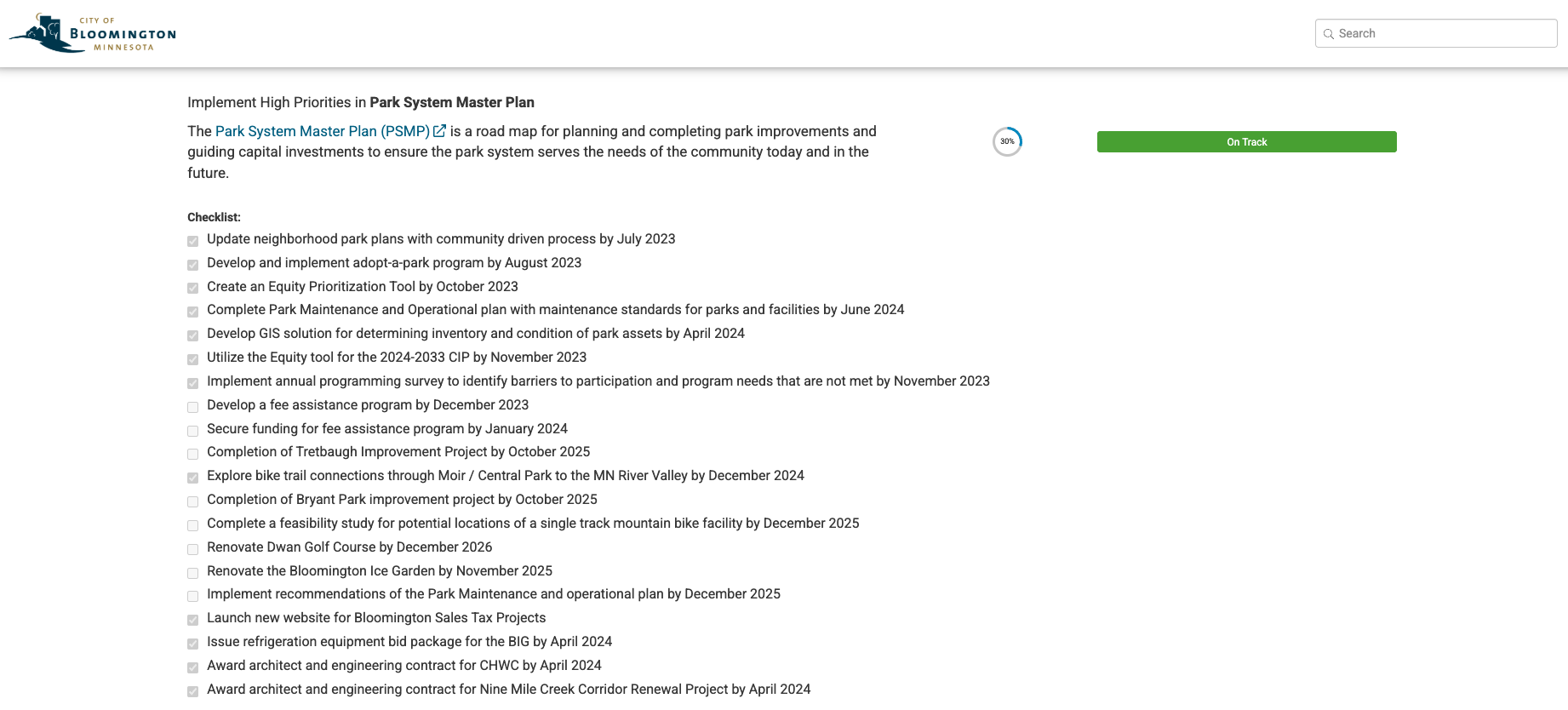Contents
- Understanding the Basics of Capital Improvement Planning
- 1. Acknowledge Differences in Process: A Capital Improvement Plan Is Not A Strategic Plan
- 2. Engage Relevant Parties Early and Often
- 3. Conduct a Comprehensive Needs Assessment
- 4. Prioritize Projects Carefully (And Identify Funding Sources)
- 5. Integrate Sustainability and Resilience
- 6. Maintain Transparency and Accountability
- Capital Improvement Plans and Managing Expectations
I was recently biking past a favorite park of mine in Toronto, along Grace Street, and noticed the roads—which had been ripped up for ages—were finally complete. I’m sure you’ve had a similar experience: going for a stroll, looking up, and seeing a new community center or bridge that’s appeared or been repaired. Then going, “Wow! Where did that come from?”
I say this partly in jest—if you’re here, it’s probably because you are working in local government and are in fact very aware of where “that” came from! Go to any city or town and you’ll find that something is being changed, added, renovated, or repaired; meaning, you’ll find capital improvement plans underway.
Capital improvement planning is a vital process for local governments. It ensures that infrastructure and public facilities meet the current and future needs of the community. A well-crafted capital improvement plan (CIP) not only addresses immediate requirements but also anticipates growth, technological advancements, and sustainability.
But here’s the thing: CIPs are complex.
Done well, with excellent communication, proper resourcing, expectation management, clear timelines, and a spirit of community engagement, they’re a total game changer for building resident trust and improving quality of life. A good CIP can demonstrate local government in action. It’s one thing to promise a new road way, recreation center, aquatics facility, etc; it’s quite another to explain why it’s going to be better, set expectations, and show the work along the way.
At their best, capital improvement plans can build community trust through well-informed and clearly articulated plans for tangible action.
At their worst… well, that’s another story.
Some CIPs are executed hastily. Some are not adequately resourced, and others are a surprise to the community (or some awful combination of all three!) This can be disastrous for building trust and getting anything done. We know it is not possible to please everyone, but it is not a stretch to suggest that there is often a high degree of mistrust and even animosity when it comes to community projects that seem to drag out forever, impacting businesses, livelihoods, and potentially eroding a sense of safety and trust in government.
In this post, we are going to look at what makes a CIP really work. We’ll explore a couple of leading examples from our own customer base and show that when it comes to capital improvement and major projects, transparency and communication are key.
Understanding the Basics of Capital Improvement Planning
A capital improvement plan is a multi-year (typically 5-10 years, but they can be longer) roadmap that outlines a local government’s intentions for public facility and infrastructure investments. They can include:
- Roads and bridges
- Water and sewer systems
- Parks and recreation facilities
- Animal services
- Public buildings (e.g., schools, public health buildings, libraries, municipal offices)
Ideally, a CIP prioritizes projects based on need, funding, and community benefit, ensuring that resources are allocated effectively.
How those budgets are actually determined is typically a fairly thorny issue, but we believe that a modernized budgeting process ought to align resources with strategic priorities and prioritize outcomes.
1. Acknowledge Differences in Process: A Capital Improvement Plan Is Not A Strategic Plan
When we talk about aligning resources, we don’t mean collapsing all planning into one process.
It’s worth noting that a strategic plan determines the vision and direction for a community, but a Capital Improvement Plan requires its own specific process. The Government Finance Officers Association (GFOA) helpfully reminds us of the similarities and differences in planning approaches. Both strategic planning and capital improvement planning require (and should strive for) organizational alignment. But a strategic plan is more about overall visions and goals, and conducting general overall assessments and scans about where one currently is.
A CIP, on the other hand, lays out the specificities required in terms of resources: determining what kind of work is needed, debt management and long-term debt capacity, risk assessment, and awareness of liabilities.
These particular features of developing a good CIP mean that silo-busting is more important than ever. The folks developing a CIP may overlap with those developing the strategic plan, but not always—and even when they do, they may not be fully aware of the other’s limitations and capacities.
Recognizing the different aims, limitations, and goals of a CIP when compared to a strategic plan is the first step to improving overall interdepartmental visibility and communication.
2. Engage Relevant Parties Early and Often
Proactivity is the name of the game. Engaging those who are either going to be working closely to delivering the plan (or who are going to have to live through the construction or with the end result) is absolutely critical—not only to the project’s success, but to the success of future projects.
Broad, cross-functional and cross-sector engagement ensures that the needs and concerns of all relevant parties are addressed from the outset, fostering a sense of ownership and collaboration.
Community involvement, internal coordination, and political leadership are all critical to a successful CIP.
In the next few sections, we’ll look at how proactive involvement in these three areas helps to identify potential issues, streamline decision-making, and enhance transparency, leading to more informed, sustainable outcomes:
Community Involvement
Engaging the community is essential. Sometimes inviting feedback is a frustrating process, but community engagement actually holds one of the biggest keys for a successful CIP.
Research from Alliance for Innovation and our partners at Polco indicate that trust in government is at an all time low. This has ramifications for everyone and every part of the government process: nobody, least of all political leaders, are left unscathed by a lack of trust.
Fixing trust is a complex process and we can’t cover it all in one blog post. But one way to improve a CIP process and build trust while doing it is by keeping the community informed.
Our own research with Arizona State University and Polco suggests that residents feeling informed is one of the top three drivers of greater trust in local government.
Public meetings, surveys, and workshops are effective tools for gathering input. Residents and other community members ought to be given a chance to ask questions, express thoughts, and be given opportunities to learn. Knowledge is power: people do tend to feel better about things when they understand what’s going on and why certain decisions are being made! Plus, surveys and outreach can provide insights into the needs and priorities of a community, ensuring the CIP reflects the collective vision.
Interdepartmental Coordination
Ensure all relevant municipal departments (public works, parks and recreation, planning, finance, etc.) are involved in the planning process. This collaborative approach helps identify overlapping needs and opportunities for integrated solutions.
Political Leadership
Leaders should be kept in the loop throughout the process. Their support is needed for approving and funding the CIP. Buy-in can be tough, but effectively engaging leadership can be improved through accessible information that is supported by data-driven decision making.
Example of Excellent Community Engagement: Bloomington, Minnesota
The City of Bloomington engaged in an exhaustive process of transparency and community engagement when developing both their strategic plan and a major capital improvement effort: their Park System Master Plan.

Online, in person, workshops, and more—Bloomington did it all.
Feedback and opinions were gathered from hundreds of individuals during community conversations held in nine parks. The input from residents and other community members at these in-person events, along with online feedback through a designated community feedback website and portal, Let’s Talk Bloomington, was invaluable in guiding the next steps in the planning process.
Using the information collected from the community, city staff and consultants convened for an all-day workshop called “Park-A-Palooza” to advance the planning process. Based on public feedback, they discussed potential changes to the nine parks and created preliminary sketches to conceptualize the new designs.
This process was deliberate and comprehensive, incorporating the voices of Bloomington residents and conducting several studies to determine how to enhance park amenities and experiences.
The result? A road map for guiding their capital investment process that actually reflects the desires of the community.
The new plan prioritizes natural resources, trails, new amenities, and equity. The adoption of the plan doesn’t mark the end of community involvement: the Park System Master Plan is a guiding document. As new projects and individual park plans are developed, ongoing community input will be essential.
3. Conduct a Comprehensive Needs Assessment
Another tip for setting your CIP up for success is ensuring a careful and data-supported assessment of current infrastructure conditions and future needs. This involves:
- Asset Inventory: Catalog existing infrastructure and public facilities, noting their condition, age, and expected lifespan
- Risk Assessment: Identify vulnerabilities, such as those due to aging infrastructure, natural disasters, or changing demographics
- Growth Projections: Use data-driven models to forecast population growth and economic development, guiding long-term planning
4. Prioritize Projects Carefully (And Identify Funding Sources)
We wish local governments had infinite resources, but not all projects can be undertaken simultaneously due to budget constraints. Prioritize projects based on:
- Urgency: Projects addressing safety concerns or legal mandates should take precedence
- Community Impact: Evaluate how projects will improve residents’ quality of life
- Economic Benefit: Consider projects that will spur economic development or offer cost savings over time
- Feasibility: Assess the technical and financial feasibility of projects, ensuring they are realistic and achievable
This prioritization process is part of developing a realistic and feasible resource allocation plan. Contingency funds should be included to cover unexpected expenses (because unfortunately, sometimes the saying is true… if it can go wrong, it will)!
And, while disruption is unavoidable, phased implementation of a CIP is also worth considering: spreading out projects over the CIP period can help when it comes to aligning with available funding, as well as minimizing disruption to the community.
Funding Sources Example: City of Ontario, California
Exploring various funding options can include looking into state and federal grants, bonds and loans, and local taxes and fees. This last option has lots of great cities to turn to for inspiration.
We recently covered innovative moves from the City of Ontario, and how they had their community approve a 1% sales tax on the ballot. This tax, called “Measure Q”, which will go on to generate an estimated $95 million in revenue for the city, to help fund major projects and plans.
The City of Ontario has been forthcoming about the kinds of projects that Measure Q could help fund. The major areas are improved drinking water access and flood control, and city-wide fiber internet services.
“We’ve been able to move forward with so many initiatives, partly due to a new sales tax measure that we just initiated called Measure Q.” – Ria Pavia, the Deputy Director of Innovation, Performance, and Audit at the City of Ontario
Ontario has been providing cost estimates for each project, including initial capital costs and long-term maintenance expenses, and sharing those with the community. When it comes to seeking alternative funding sources, having your community behind you can save a lot of time and money.
5. Integrate Sustainability and Resilience
Modern CIPs should incorporate sustainability and resilience principles to address environmental concerns and enhance infrastructure durability. Consider:
- Green Infrastructure: Projects that reduce environmental impact, like permeable pavements and green roofs
- Climate Resilience: Infrastructure designed to withstand extreme weather events and climate change effects
- Energy Efficiency: Incorporating energy-efficient technologies to reduce operating costs and environmental footprint
6. Maintain Transparency and Accountability
We are always talking about how government moves at the speed of trust. That is particularly visible when it comes to a CIP. We’ve already talked about the importance of creating avenues for feedback and engagement, but now we are going to talk about the specifics of communication, transparency, and accountability.
Maintaining transparency and accountability in a CIP is vital for local governments because it builds public trust and ultimately ensures the responsible use of public funds. Transparency should involve regularly updating the community on the progress of CIP projects through public reports, meetings, and digital platforms.
Everyone knows a healthy relationship requires good communication. This includes local government!
Ideally, there should be a continuous flow of information that keeps everyone informed about how their tax dollars or the relevant resources are being spent. By openly sharing project timelines, budgets, and outcomes, local governments can demonstrate their commitment to effective governance and accountability, which in turn encourages public support and participation.
Here are some practical steps for transparency and accountability:
- Establish relevant and clear performance metrics for evaluating the success of completed projects. These metrics might include project completion times, budget adherence, and community satisfaction, providing clear benchmarks for assessing progress and identifying areas needing improvement.
- Regularly review and update the CIP to reflect changing priorities, new opportunities, and lessons learned from completed projects. Remember how we said a strategic plan and a CIP are not exactly the same, but they need to be organizationally aligned? It’s important your CIP remains relevant and responsive to community needs.
- Make use of a designated public sector CIP project management tool. Tools like Envisio’s public sector project management feature can greatly enhance these efforts by offering a centralized platform for managing CIP projects. This feature facilitates tracking progress, managing budgets, and enhancing communication among relevant parties, making it easier to maintain a transparent and accountable CIP process.
Transparency and Rigorous Tracking Example: City of Denton, Texas
The City of Denton, Texas, are real pioneers when it comes to transparency and performance metrics. Their Envisio public dashboard offers real-time updates on the progress of major projects, making it easy for residents to stay informed about developments. This transparency builds community trust by allowing residents to see exactly how funds are being used and projects are advancing. It also keeps folks on track with the overall plan, enabling the city to evaluate project success based on completion times, budget adherence, and community satisfaction.

You can find most information pertaining to their CIP under their “Enhance Infrastructure and Mobility” pillar, however their CIP is woven across all of these areas. Here is just a short selection a few of the projects they have completed:
Plan for Infrastructure Needs: Engaged a third party to evaluate cost-effective methods for road improvements and long-term financial planning.
Improve Capital Project Planning and Communication: Enhanced project delivery processes and communication tools for transparent and effective planning.
Develop Bond Program for FY 2022-23: Created a Citizen Bond Committee. Established to guide the bond program focusing on quality of life and facilities projects.
Conduct Facilities Master Plan: Created a strategic document for the development and maintenance of city facilities.
And a few more items on their CIP that are in progress:
Develop New Fleet Services Facility at Solid Waste: They are engaged in designing a new facility to support growing operations.
Renovate Municipal Facilities and Facility Upgrades: Renovations at City Hall to support city operations and staff growth.
Improve Aquatics Facilities: They are making a budget request of $425,000 for renovations and efficiency upgrades.
Revamp Downtown Drainage System: This is mainly directed towards flood mitigation. Projects include drainage system enhancements and new infrastructure.
Like we said, this is only a very, very short list of what they’ve got underway.
Capital Improvement Plans and Managing Expectations
A well-designed Capital Improvement Plan is a cornerstone of effective local governance. Creating avenues for engagement, prioritizing wisely, and busting silos can and will go a long way in creating robust CIPs that enhance infrastructure, boost economic development, and improve residents’ quality of life.
Transparent and accountable processes further ensure that these plans remain aligned with community needs and expectations.
Really, the big thing to come away with is the importance of managing expectations.
Bad CIPs can significantly hinder a community’s development, drain financial resources, and diminish public trust in local government. Keeping things focused, prioritized, and showing off your progress will really help you through the process of your CIP, laying the groundwork for a thriving, resilient community.




